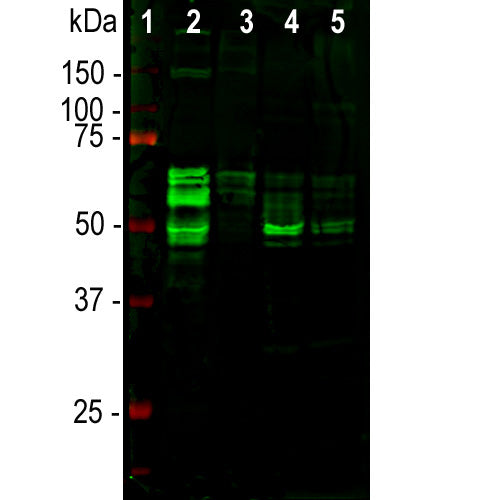

EnCor Biotechnology
Chicken Polyclonal Antibody to Microtubule Associated Protein Tau, MAP-τ (Tau), Cat# CPCA-Tau
Description
The CPCA-Tau antibody was raised against a recombinant form of one of the lower molecular weight human τ isoform, specifically the human 441 amino acid htau40 form described by Goedert et al. We document that the antibody works well not only for western blotting, IF and ICC but also on formalin fixed paraffin embedded sections, select the "Additional Data" for this data. We have two mouse monoclonal antibody raised against the same form of human τ, MCA-2E9 and MCA-5B10. All three antibodies recognize the unphosphorylated forms of MAP-τ and the monoclonals have been epitope mapped to distinct regions of the τ molecule.
- Cell Structure Marker
- Cell Type Marker
- Chicken Polyclonal Antibodies
- Immunohistochemistry Verified
- Pathology Related Marker
Add a short description for this tabbed section
| Immunogen: | Recombinant full length version of the shortest human Tau isoform purified from E. coli. |
| HGNC Name: | MAPT |
| UniProt: | P10636 |
| Molecular Weight: | 48-67kDa by SDS-PAGE |
| Host: | Chicken |
| Species Cross-Reactivity: | Human, rat, mouse, cow, pig, horse |
| RRID: | AB_2572348 |
| Format: | Concentrated IgY preparation plus 0.02% NaN3 |
| Applications: | WB, IF/ICC, IHC |
| Recommended Dilutions: | WB: 1:10,000. IF/ICC 1:2,000 and IHC: 1:10,000. |
| Storage: | Store at 4°C. Stable for 12 months from date of receipt. |
Tau is a low molecular weight member of the microtubule associated protein or MAP family. Several serious human diseases are associated with accumulations of tau protein, most notably the neurofibrillary tangles of Alzheimer's disease. Accumulations of tau in neurons are also characteristic of chronic traumatic encephalopathy, Pick's disease and several other neurodegenerative diseases. Together these disorders are known as "tauopathies". The single mammalian tau gene produces at least 9 different proteins by alternate transcription. In the central nervous system 6 isoforms ranging from 48-67kDa by SDS-PAGE predominate, though larger isotypes are seen mostly in the peripheral nervous system. The tau molecules are very heavily charged and run on SDS-PAGE much more slowly than predicted from their real molecular size. For example the smallest human tau isotype runs at 48kDA on SDS-PAGE but the real molecular weight is 32kDa. Tau proteins are substrates for ser/thr phosp

Chromogenic Immunostaining of a formalin fixed paraffin embedded human cortical section from an Alzheimer’s disease patient was stained with CPCA-Tau, dilution 1:10,000. Staining was detected with DAB (brown) using the ABC method with citrate buffer retrieval at pH=6.0. Hematoxylin (blue) was used as the counterstain. The CPCA-Tau antibody labels neurofibrillary tangles in the cytoplasm of diseased neurons producing a characteristic flame shaped morphology and also highlights dystrophic neurites associated with senile plaques. Mouse select image for larger view.
1. Weingarten, M. D., Lockwood, A. H., Hwo, S.-Y. and Kirschner, M. W. A protein factor essential for microtubule assembly. PNAS 72:1858–62 (1975).
2. Cleveland, D. W., Hwo, S. Y., Kirschner, M. W. Purification of tau, a microtubule-associated protein that induces assembly of microtubules from purified tubulin. J Mol. Biol. 116:207-25 (1977).
3. Goedert, M., Spillantini, M. G. A century of Alzheimer’s disease. Science 314:777–81 (2006).
4. Ballatore, C., Lee, V. M., Trojanowski, J. Q. Tau-mediated neurodegeneration in Alzheimer’s disease and related disorders. Nat. Rev. Neurosci. 8:663–72 (2007).
5. Wolfe, M. S. Tau mutations in neurodegenerative diseases. J. Biol. Chem. 284:6021-6025 (2009).
6. Goedert M, Spillantini MG, Crowther RA. Cloning of a big tau microtubule-associated protein characteristic of the peripheral nervous system. PNAS 89:1983-7 (1992).
7. Boyne LJ, Tessler A, Murray M, Fischer I. Distribution of Big tau in the central nervous system of the adult and developing rat. J. Comp. Neurol. 358:279-93 (1995).
Add a short description for this tabbed section





